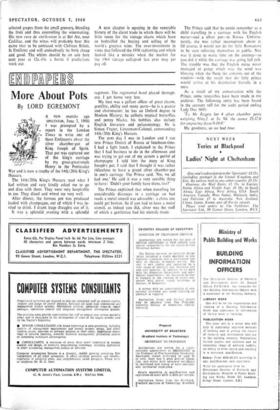CONSUMING INTEREST
Claret Crisis
By LESLIE ADRIAN
Meanwhile, in the, past week or so, the head- quarters of Calvet, Bordeaux's greatest nego- ciants, has been burnt down, taking with it innumerable reserves of great vintages. The Sauternais has had three bad years in succession and is now in a state of revolution. And the celebrated châteaux of Margaux, Cos d'Estour- nel and Branaire-Ducru, tired of taking the bad years with the good ('63 and '65 were poor, and '64 was eventually overpriced), have decided to follow the example of Champagne and blend the off years. Indeed, next year, customers of Gilbey's, who have the sole distribution rights of Branaire in Britain, will be able to buy château-bottled claret from this vineyard, ready for the table, blended from 25 per cent of 1963, 25 per cent 1964 and 50 per cent 1965. It will cost less than £1 a bottle according to present calculations, perhaps a trifle above the final price of the 1965. Even now this fourth growth is enjoyable, though not quite 'ready,' and prob- ably deserves the Lichine promotion to the grade of Grand Cru, to which he would also raise his own Le Prieure.
The gain for the consumer from this new move is that no longer will he have to struggle to recall which were the good vineyards in off years, nor fall for the high-priced, poor wines selling on their reputations in bad years. No names, no pack drill. During the three night- mare years in Sauternes the local committees stretched the appellation control& tolerances to breaking point so that the growers could get the prices for their named wines that mere regional names could never fetch. But all over France fakes from lesser white wine areas of Bordeaux were being passed off as Sauternes at three or four francs a bottle. The trick did not work. Now the proud growers of Sauternes have formed a marketing group (groupement des producteurs), with official backing, to control the sale of wines using their name and allow- ing no more than about twenty shippers all over the world to handle them. Only in Britain, under licence, and in the cellars of the Scandinavian monopolies; will true Sauternes be bottled out- side the region in future.
For years the big Bordeaux middlemen have tried to blend clarets that would please the home and export markets year after year regardless of the vagaries of weather (the frost disaster of 1956 rankles after ten years). Grape-growing is only another kind of farming and just as sus- ceptible to bad husbandry as to climate. Cynics have often wondered what became of the wines of the bad years and whether they were not passed off in some way as better than they could be. The truth is that in their heyday the great châteaux always sold off their poor vintages as Medoc or St Estephe or whatever seemed appro- priate, and stood the loss rather than lose face. They can no longer afford this doble sacrifice, and the blending of the poor years with the better supplies an answer, even if it does upset some traditionalists who regard such methods as cuisine rather than vinification. It may also raise prices on the average, but it should even them out over the years as well.
Within the château the mixing of different years can be controlled and is bound to produce a wine of some distinction. Lower down the scale, as dealers have found to their cost, the blending of wines from different, smaller growers is a more difficult business, because not all the minor vignerons know how to make sound wine. Peter Sichel, head of the shipping firm of Sichel and Son and proprietor of Palmer and Angludet, is just introducing into Bordeaux the method of the Alsatian blenders (and, incidentally, of some port-makers, notably Croft's) of buying selected grapes from the small growers, blending the fruit and thus controlling the winemaking. His new cave de vinificatton is at Bel Air, near Cadillac, and the wines will probably bear this name (not to be confused with Château Belair, St Emilion) and will undoubtedly be both cheap and good. The whites should be on sale here next year at 12s.-14s. a bottle if predictions work out. A new chapter is opening in the venerable history of the claret trade in which there will be little room for the vintage charts which have so bedevilled the buying and selling of the world's greatest wine. The over-investment in vines that followed the 1956 replanting and which looked like a mistake when the market for the 1964 vintage collapsed last year may yet pay off. The Prince said that be could remember as a child travelling in a carriage with his English nurse—and a silver pot—in Russia Unfortu- nately, she was rather incompetent about it. Of course, it would not do for little Romanovs to be seen relieving themselves in public. Nor was it done to waste time on the journey—so you did it while the carriage was going full pelt. The trouble was that the English nurse never managed to gauge which way the wind was blowing when she flung the contents out of the window—with the result that the little prince would arrive at his destination literally in a mess.
As a result of my conversation with the Prince, some researches have been made in my archives. The following entry has been found in the account roll for the audit period ending Lady Day 1695:
'To Mr Rogers for 4 silver chamber from weighing 91 oz.2. at 5s. 9d. the ounce 25.17.6 for engraving them 0-10-0.'
My goodness, so we had four.



































 Previous page
Previous page